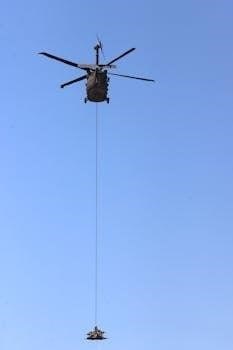The 3-4 defense, utilizing three defensive linemen and four linebackers, has gained popularity across NFL and college football. This scheme provides flexibility, allowing for diverse pressure and coverage options, often overwhelming offensive blocking schemes. The two-gap approach is crucial for defensive linemen in this structure.
Overview of the 3-4 Defensive Formation
The 3-4 defensive formation is characterized by its three down linemen and four linebackers, positioning itself as a versatile and adaptable strategy. Unlike a 4-3, which features four linemen, the 3-4 prioritizes linebacker athleticism and scheme flexibility. This setup requires bigger, stronger defensive linemen capable of controlling two gaps, demanding a unique skill set compared to other defensive alignments. The outside linebackers play a hybrid role, often shifting between rushing the passer and dropping into coverage, adding complexity to the offensive blocking schemes. This formation allows for a variety of blitz packages and coverage options, creating a dynamic and unpredictable defense. The linebacker positions have specific names depending on the particular playbook used, reflecting the adaptability of the system. The 3-4 has seen a resurgence in popularity in both the NFL and college football due to its adaptability and effectiveness in modern football. This formation provides a unique challenge for offenses and is known for creating opportunities for turnovers.

Key Positions in the 3-4 Defense
The 3-4 defense relies on specific player roles. Defensive linemen must control two gaps, while outside linebackers are versatile, rushing or covering. Inside linebackers are crucial for run support and pass defense.
Defensive Line Responsibilities in a 3-4
In the 3-4 defense, the defensive line’s primary responsibility is to control multiple gaps, commonly referred to as a two-gap technique. This approach differs significantly from a 4-3 scheme, where linemen typically engage in one-gap assignments. The defensive linemen in a 3-4 must possess the strength and technique to engage offensive linemen, preventing them from reaching the linebackers. This allows the linebackers to flow freely towards the ball carrier and make plays. The nose tackle, often positioned directly over the center, must be a powerful force to disrupt the interior running game. Defensive ends, typically lining up on the offensive tackles, must have the ability to both control their gaps and rush the passer. Their ability to command two gaps is critical, freeing up linebackers to pursue the ball. The effectiveness of the 3-4 defense relies heavily on the defensive line’s ability to execute their two-gap responsibilities effectively, controlling the line of scrimmage and disrupting the offensive flow, making the game easier for the linebackers. This also allows for more diverse blitzing options.
Linebacker Roles and Variations in the 3-4
In the 3-4 defensive scheme, linebackers assume diverse roles, demanding versatility and athleticism. Outside linebackers often display a hybrid nature, possessing the ability to rush the passer as well as drop into coverage. These players need to be adept at both setting the edge against the run and disrupting the quarterback. Inside linebackers are typically responsible for controlling the middle of the field, reading the play, and making tackles. They are often called Mike, Will and Sam. The Sam linebacker, is crucial, needing to be able to defend the run and cover receivers in the pass game, especially on the wide side of the field. Linebacker roles in the 3-4 can vary greatly depending on the specific playbook and the team’s strategy. Some schemes might emphasize blitzing from the linebackers, while others may prioritize coverage. This adaptability is a key strength of the 3-4, allowing for different looks and adjustments based on the opponent’s offense and their personnel.

3-4 Defense Playbook Fundamentals
Mastering the 3-4 defense requires a solid understanding of its core principles. This includes techniques like two-gap control for linemen, and recognizing the hybrid roles of the outside linebackers, which are crucial to success in this scheme.
Two-Gap Technique for Defensive Linemen in 3-4
In the 3-4 defense, the defensive linemen are tasked with employing a two-gap technique, a fundamental aspect of their responsibilities. This approach requires them to control two gaps on either side of an offensive lineman, rather than just one. This differs significantly from a one-gap system where a lineman attacks a single designated gap. This two-gap responsibility demands exceptional strength, technique, and mental discipline. Linemen must engage the offensive lineman, maintain leverage and then disengage to make a play on the ball carrier. By controlling two gaps, the defensive linemen can disrupt blocking schemes and create opportunities for linebackers to make tackles, or to stop running plays before they get started. The goal is not necessarily to penetrate deep into the backfield, but to maintain position, occupy the offensive line and allow the linebackers to flow to the ball. This requires the defensive linemen to be bigger, stronger and more disciplined. The success of the entire 3-4 defense hinges on the defensive line’s ability to execute this two-gap technique effectively.
Hybrid Nature of Outside Linebackers in 3-4
The outside linebackers in a 3-4 defense embody a hybrid role, demanding a versatile skillset that combines pass-rushing and coverage abilities. Unlike traditional linebackers who primarily focus on run support and zone coverage, these players must effectively pressure the quarterback while also being capable of dropping into pass coverage. This hybrid nature requires exceptional athleticism, agility, and football intelligence. They must be able to read offensive formations, diagnose plays quickly, and react accordingly. In run situations, they need the strength to set the edge and contain the outside. In passing situations, they must possess the speed and technique to rush the passer effectively and disrupt the quarterback. They also need the awareness to drop into zones and cover pass routes. This two-fold responsibility makes the outside linebacker position a crucial part of the 3-4’s defensive success. Their ability to seamlessly transition between pass rushing and coverage is a key element that makes the 3-4 defense so adaptable and hard to predict, and a critical component of a successful 3-4.
Common 3-4 Defensive Schemes
The 3-4 defense employs various schemes, including diverse blitz packages that pressure the quarterback, and coverages to defend against the pass. These schemes adjust to different offensive formations, creating a flexible defense.
Blitz Packages and Coverages in a 3-4
The 3-4 defense is renowned for its versatile blitz packages, which can involve any of the four linebackers, creating unpredictable pressure on the quarterback. These blitzes are often designed to exploit weaknesses in the offensive line or to confuse blocking assignments. Common blitzes include zone blitzes, where linebackers drop into coverage after feigning a rush, and overload blitzes, where multiple linebackers attack from one side. Coverage schemes in a 3-4 can vary from Cover 2 and Cover 3 to man-to-man, providing flexibility against different passing attacks. A key to successful 3-4 defense is the ability to disguise blitzes and coverages, making it difficult for the offense to anticipate what is coming. The hybrid nature of outside linebackers allows them to both rush the passer and drop into coverage, further complicating the offensive game plan. The diverse blitz packages and coverages make the 3-4 defense a challenging scheme to face.
Adjusting the 3-4 to Opponent Formations
A crucial aspect of a successful 3-4 defense is its adaptability to various offensive formations. Coaches must analyze opponent tendencies and adjust player alignments accordingly. Against a heavy run formation, the defensive line may shift to create a stronger front, while linebackers may move closer to the line of scrimmage. When facing a pass-heavy team, outside linebackers might drop into coverage more frequently, and secondary players may shift to provide better pass defense. The 3-4’s flexibility allows for numerous adjustments. For example, against spread offenses, the defense might employ more zone coverage and quick blitzes to disrupt the quarterback. Conversely, against power running teams, the defensive line might play a more two-gap style, engaging blockers to free up linebackers. Effective adjustments are vital for negating an offense’s strengths and exploiting their weaknesses. It is about countering what they do best, minimizing the effect of their best weapons.

Historical and Modern Use of the 3-4
The 3-4 defense was most popular in the NFL during the 1970s and 1980s. It has seen a resurgence in recent years in both professional and college football, due to its adaptability.
3-4 Defense in the NFL and College Football
The 3-4 defense has a rich history in both the NFL and college football. It experienced widespread use in the NFL during the 1970s and 1980s, becoming a staple for many teams. In recent years, this defensive scheme has seen a resurgence at both the professional and collegiate levels. Teams are drawn to its flexibility and the ability to create varied pressure packages. The 3-4’s adaptability allows defenses to adjust to diverse offensive strategies, making it a popular choice. Its effectiveness against both the run and pass has led to its re-emergence as a prominent defensive system. The scheme’s reliance on versatile linebackers who can rush or drop into coverage makes it a dynamic option in modern football, utilized by many teams across different levels. The success of teams employing the 3-4 continues to solidify its place in the defensive landscape of both the NFL and college football.
Evolution of the 3-4 Defense Over Time
The 3-4 defense has undergone significant evolution since its initial implementation. Originally, it was employed as a means to counter specific offensive formations prevalent in earlier eras of football. As offenses evolved, the 3-4 adapted, incorporating new techniques and player roles. The hybrid nature of outside linebackers, capable of both pass rushing and coverage, became a crucial element in its development. This shift allowed defenses to be more unpredictable and versatile. The scheme’s flexibility enabled teams to adjust to different offensive styles, whether it be a run-heavy attack or a pass-oriented approach. The modern 3-4 emphasizes speed and athleticism, with linebackers playing a more dynamic role in the defense. Furthermore, the two-gap technique for defensive linemen became a standard, enabling them to control multiple gaps on the line of scrimmage. These changes reflect the continuous evolution of the 3-4 to remain competitive in football.

Advantages and Disadvantages of the 3-4
The 3-4 defense offers varied pressure and coverage, utilizing hybrid linebackers. However, it can be vulnerable to strong running games due to fewer down linemen, potentially overwhelming the linebackers.
Strengths of the 3-4 Defense
The 3-4 defense’s primary strength lies in its ability to create varied and unpredictable pressure on the quarterback. With four linebackers, it presents more blitzing options compared to a 4-3, making it harder for offenses to anticipate defensive moves. The hybrid nature of outside linebackers allows for adaptability, as they can both rush the passer and drop into coverage, keeping offenses guessing. This flexibility extends to coverage schemes, which can be disguised more easily, leading to turnovers and disrupted plays. Furthermore, the 3-4 often employs bigger, stronger defensive linemen who are adept at controlling multiple gaps, thus disrupting offensive blocking schemes. This approach can overwhelm offensive lines, creating opportunities for linebackers to make plays. The 3-4 also excels at confusing offensive protections, as the front seven alignment can shift, presenting a different look pre-snap. Overall, the versatility and adaptability of the 3-4 makes it a potent defensive system, capable of generating pressure and turnovers.
Potential Weaknesses of the 3-4 Defense
Despite its strengths, the 3-4 defense has potential weaknesses. One significant challenge is that without a fourth defensive lineman, the front three can be overwhelmed by strong offensive lines, particularly in the running game. This puts additional pressure on the linebackers to fill gaps and make tackles, potentially leaving them vulnerable. The need for defensive linemen to control two gaps requires high levels of skill and can be physically demanding, and a lack of depth at this position can severely impact the defense. Additionally, the hybrid nature of outside linebackers, while beneficial, can also be a weakness if they are not proficient in both pass rushing and coverage. The complexity of the 3-4 scheme can sometimes lead to communication breakdowns, and if players don’t execute their assignments correctly, offenses can exploit the gaps and misalignments. Furthermore, the success of the 3-4 often depends on having a strong nose tackle capable of controlling the center, and finding such a player can be challenging.




